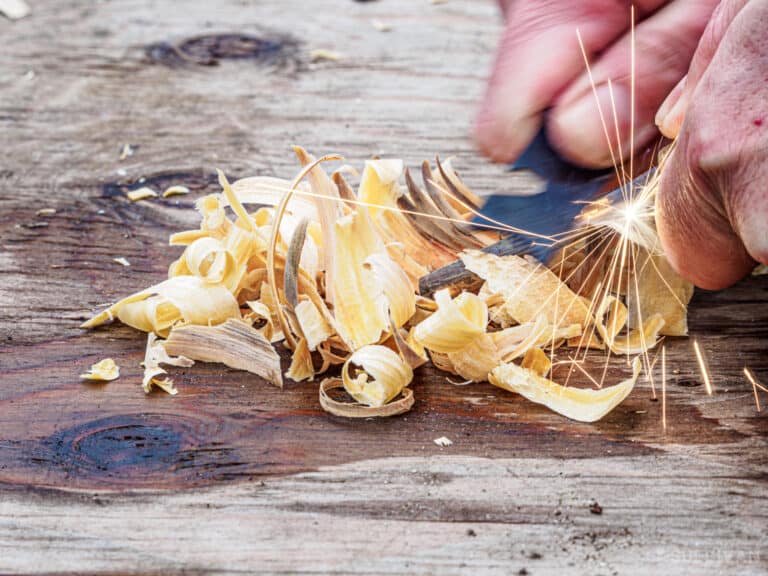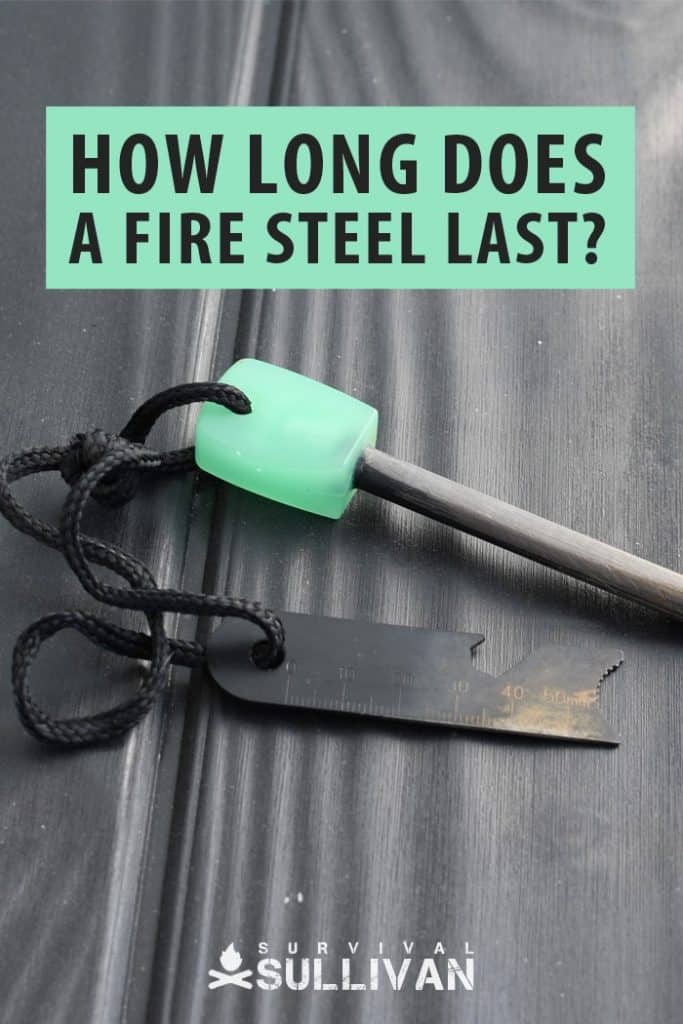Fire steels are time-tested and effective fire starting implements for backpacking, hiking, and emergency preparation. Weighing next to nothing and taking up very little room in a pack, almost every prepper has one or two as part of their kit.
With one good scratch from the striker, a fire steel will produce a shower of white-hot sparks capable of igniting almost any tinder and most conditions, wet, damp or dry.

Considering they don’t use fuel like lighters, a fire steel can basically go on lighting forever, right? Not exactly. Fire steels do wear out. How long it takes depends on a couple of factors.
An average fire steel will provide anywhere from 7,000 to 15,000 uses. A larger, harder steel may afford you well in excess of 15,000 lights. A smaller, softer steel may only afford you 5,000, or even less. Any of those extremes can be modified by how often the steel is used and how skillfully.
The number of uses one can expect to get is so variable, because the fire steels themselves come in many different diameters, are made from alloys of varying hardness or softness, and will be used by people that are more or less skilled in their operation.
There is no exact standard for how long a fire steel of a given thickness or length will last under field conditions. Manufacturers’ estimates are only guidelines, and are typically on the high side of actual use.
That being said, it is possible for a savvy prepper to assess a given fire steel’s characteristics and determine roughly how long it should last.
How Can a Piece of Steel Wear Out?
Anything can wear out, reader, including the highest grade steels. Incidentally though we aren’t talking about real steel; fire steel as commonly marketed today is actually most often made from ferrocerium, a man-made alloy that turns white hot when it oxidizes.
Ferrocerium in common usage as a fire-starting implement is usually oxidized when struck by an actual piece of steel, or striker, where the tiny fragments and flakes heat up drastically under friction. These particles are the shower of sparks that light our fires!
If you think this operation through, every time you employ your fire steel you are grinding off a very small portion of it in order to produce sparks to start your fire.
While the amount used up is tiny, and you probably won’t even notice it, do this again and again and overtime and you’ll start to, literally, grind away your fire steel. Nothing lasts forever.
One major consideration when determining the wear characteristics of fire steel is whether this ferrocerium alloy is a harder or a softer blend.
Now, none of them are soft to the touch, but a softer alloy will shed its weight much more readily when struck.
This produces a much larger plume of sparks, but consumes more of the fire steel every time it is used. A harder alloy loses fewer particles and lasts longer all things being equal, but it sparks with less intensity.
Both are completely viable and usable. It just pays to be aware of which brands are harder or softer so you may choose a fire steel suitable to your preferences.
What’s the best fire steel out there?
There are lots of options when it comes to fire steel. one of the most liked brands is Light my fire, whose fire steel should last you at least 12,000 sparks according them them.
However, if you want to be 100% sure you’re getting the best one, here’s a video of one fellow testing no less than 20 of them:
Diameter
If you control for all the other variables, the diameter and length of the fire steel is the second most important factor in determining how long it will last in use.
Typical commercial fire steels can be had in sizes ranging from 1/2 inch in diameter on the large end of the spectrum all the way down to 3/16 of an inch or even smaller on the small end of the spectrum.
Everyone has a preference depending on how they like to use the fire steel and plainly stated a fire steel with a greater volume will last longer than one with a smaller volume.
I’m not saying it will be five lights and done or anything like that, but a smaller fire steel made from a softer ferrocerium alloy will start shrinking noticeably when you use them heavily in practice or in the field.
You should still get a few hundred uses at the very minimum, but if you want one that can stand the test of time, look at a fire steel that is longer, larger diameter and made from a harder alloy.
Not That Fire Steel!
It is worth clarifying that the fire steel in question in the context of this article is a modern ferrocerium and striker arrangement, not a regular piece of actual steel used with flint or chert back in the old days.
The distinction is important: a modern fire steel (ferro rod) is an alloy specially formulated to be pyrophoric.
A bog-standard piece of steel used with a flint is not, though the mechanism by which it is used (striking it with a harder striker, in this case the flint) produces a shower of hot particles similarly to a ferro rod arrangement.
If you are using a piece of steel with flint or chert in the old ways it may last longer or not nearly as long as a modern fire steel.
Beware Corrosion
There’s one more factor that can dramatically shorten the life of any fire steel, and that is corrosion. This alloy will rust if it gets wet and is not cared for. Be it rain or sweat, a fire steel will rust quickly from either if it is left alone.
I do not have any reliable data as to how much and how quickly its service life will be reduced by corrosion, but I can tell you from personal experience that putting one away wet (accidentally or deliberately) will see you take it out a couple of months later with it on the verge of being a crumbly mess.
Even if your fire steel is only an item in your everyday carry (EDC) kit, wipe it dry when you’re done carrying it and give it a quick coat of very light oil to help drive moisture out.
No matter what kind of fire steel you have, this will dramatically increase its service life.
Conclusion
You can expect an average fire steel to provide you anywhere from 7,000 to 15,000 uses depending on the length and composition of the fire steel itself. A smaller diameter, shorter length and softer alloy will reduce the amount of uses available to you.
Conversely, a longer, larger diameter fire steel made from harder alloy will afford you many more uses before it gives up the ghost.
Make sure you consider all the variables when purchasing and employing a fire steel so you’re not left without one when you require it.


Tom Marlowe practically grew up with a gun in his hand, and has held all kinds of jobs in the gun industry: range safety, sales, instruction and consulting, Tom has the experience to help civilian shooters figure out what will work best for them.
